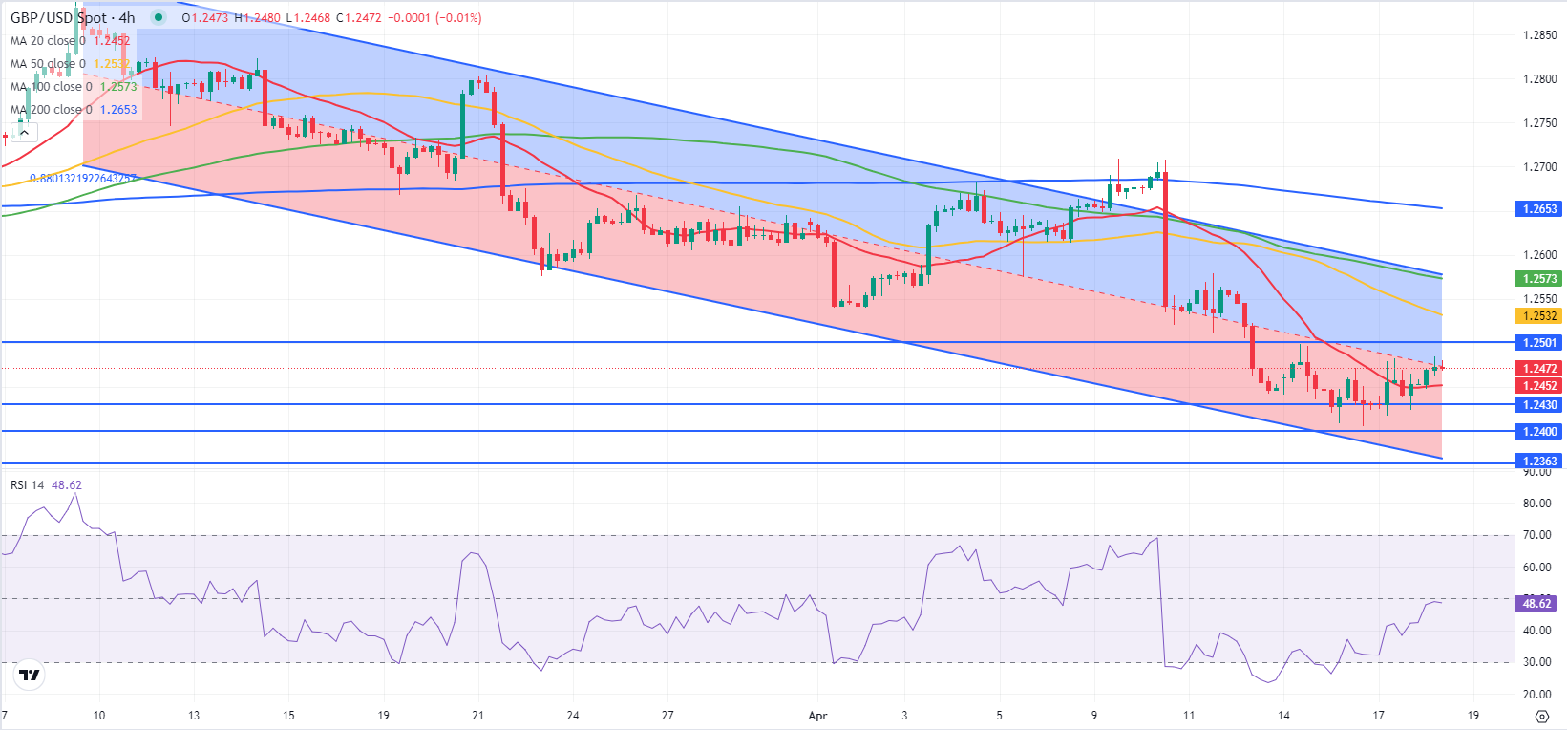GBP/USD Forecast: Pound Sterling could extend rebound on improving risk mood
- GBP/USD stays in a consolidation phase below 1.2500 on Thursday.
- Near-term technical outlook is yet to show a buildup of recovery momentum.
- A further improvement in market mood could help the pair push higher.
GBP/USD gained traction in the early European session on Wednesday following the stronger-than-expected Consumer Price Index (CPI) data from the UK but struggled to gather bullish momentum. After closing the day marginally higher, the pair seems to have gone into a consolidation phase below 1.2500 on Thursday.
Pound Sterling price this week
The table below shows the percentage change of Pound Sterling (GBP) against listed major currencies this week. Pound Sterling was the strongest against the Japanese Yen.
| USD | EUR | GBP | CAD | AUD | JPY | NZD | CHF | |
| USD | -0.29% | -0.10% | -0.04% | 0.44% | 0.69% | 0.26% | -0.57% | |
| EUR | 0.30% | 0.20% | 0.28% | 0.75% | 0.99% | 0.56% | -0.27% | |
| GBP | 0.08% | -0.20% | 0.05% | 0.52% | 0.77% | 0.33% | -0.49% | |
| CAD | 0.02% | -0.27% | -0.08% | 0.48% | 0.71% | 0.27% | -0.55% | |
| AUD | -0.46% | -0.76% | -0.58% | -0.50% | 0.23% | -0.20% | -1.04% | |
| JPY | -0.67% | -0.97% | -0.77% | -0.73% | -0.25% | -0.42% | -1.27% | |
| NZD | -0.25% | -0.56% | -0.37% | -0.29% | 0.20% | 0.45% | -0.84% | |
| CHF | 0.55% | 0.25% | 0.45% | 0.51% | 0.99% | 1.25% | 0.80% |
The heat map shows percentage changes of major currencies against each other. The base currency is picked from the left column, while the quote currency is picked from the top row. For example, if you pick the Euro from the left column and move along the horizontal line to the Japanese Yen, the percentage change displayed in the box will represent EUR (base)/JPY (quote).
Commenting on the inflation report, Bank of England (BoE) Monetary Policy Committee (MPC) member Megan Greene said on Wednesday that the data was encouraging but added that she is worried about what an energy price shock and other supply side shocks might do to inflation expectations.
Meanwhile, retreating US Treasury bond yields made it difficult for the US Dollar (USD) to gather strength and allowed GBP/USD to stay in positive territory in the American session midweek.
Early Thursday, the positive shift seen in risk mood is helping GBP/USD hold its ground. In case Wall Street’s main indexes open in positive territory and continue to stretch higher, the USD could remain under bearish pressure in the second half of the day.
The US economic docket will feature weekly Initial Jobless Claims data. Markets expect the number of first-time applications for unemployment benefits to rise to 215,000 from 211,000 in the previous week. A reading close to 200,000 could help the USD stay resilient against its peers and limit GBP/USD’s upside.
GBP/USD Technical Analysis
GBP/USD stays near the mid-point of the descending channel and the Relative Strength Index (RSI) indicator on the 4-hour chart moves sideways slightly below 50, highlighting a lack of buyer interest.
GBP/USD could face first resistance at 1.2500 (psychological level, static level) before 1.2560 (static level) and the 200-day Simple Moving Average (SMA) at 1.2580.
On the downside, 1.2450 (20-period SMA) aligns as interim support before 1.2400 (psychological level, static level) and 1.2360 (lower limit of the descending channel).
Pound Sterling FAQs
The Pound Sterling (GBP) is the oldest currency in the world (886 AD) and the official currency of the United Kingdom. It is the fourth most traded unit for foreign exchange (FX) in the world, accounting for 12% of all transactions, averaging $630 billion a day, according to 2022 data. Its key trading pairs are GBP/USD, aka ‘Cable’, which accounts for 11% of FX, GBP/JPY, or the ‘Dragon’ as it is known by traders (3%), and EUR/GBP (2%). The Pound Sterling is issued by the Bank of England (BoE).
The single most important factor influencing the value of the Pound Sterling is monetary policy decided by the Bank of England. The BoE bases its decisions on whether it has achieved its primary goal of “price stability” – a steady inflation rate of around 2%. Its primary tool for achieving this is the adjustment of interest rates. When inflation is too high, the BoE will try to rein it in by raising interest rates, making it more expensive for people and businesses to access credit. This is generally positive for GBP, as higher interest rates make the UK a more attractive place for global investors to park their money. When inflation falls too low it is a sign economic growth is slowing. In this scenario, the BoE will consider lowering interest rates to cheapen credit so businesses will borrow more to invest in growth-generating projects.
Data releases gauge the health of the economy and can impact the value of the Pound Sterling. Indicators such as GDP, Manufacturing and Services PMIs, and employment can all influence the direction of the GBP. A strong economy is good for Sterling. Not only does it attract more foreign investment but it may encourage the BoE to put up interest rates, which will directly strengthen GBP. Otherwise, if economic data is weak, the Pound Sterling is likely to fall.
Another significant data release for the Pound Sterling is the Trade Balance. This indicator measures the difference between what a country earns from its exports and what it spends on imports over a given period. If a country produces highly sought-after exports, its currency will benefit purely from the extra demand created from foreign buyers seeking to purchase these goods. Therefore, a positive net Trade Balance strengthens a currency and vice versa for a negative balance.


